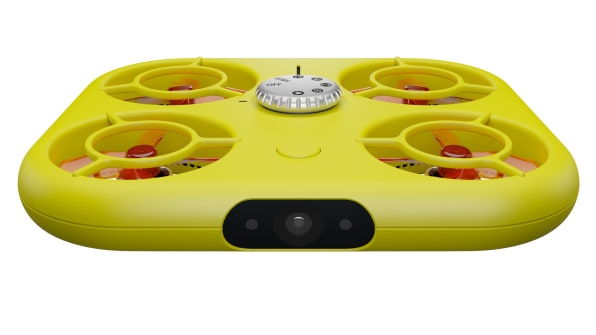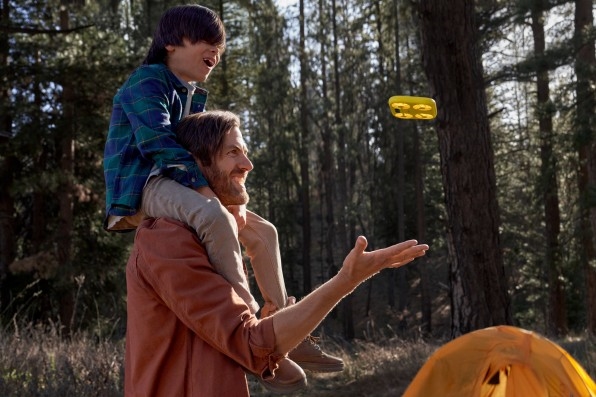The Snap Pixy: A shockingly simple drone that redefines the selfie
I have a magical backyard—though it wouldn’t look like that to you. Sure, I plant dozens of flowers and herbs each year, and spend a bit too much to have my lawn mowed. But I have a fence that’s falling down, patches of mud from my dog, and, ugh, power lines. So the magic of my backyard is less visual than experiential; it’s the sensation of jumping through the sprinkler during sunset.

I say all this to convey a point: Every photo I’ve ever taken of my backyard fails to capture the memories of my mind’s eye. That was, until I launched Snap’s new Pixy drone from my hand, and it flew in a graceful arc around my daughter and me. As it captured my daughter’s smile and the blowing leaves in our neighborhood trees, my backyard was suddenly my backyard, a world of cinematic proportions and nostalgia generated in every moment.
And I realize, oh. This is why Snap—a multimedia platform with 332 million daily users—still refers to itself as a humble “camera company.” It has slowly but surely become a master at capturing a moment, even if its stock plunged 40% this week in response to its struggling ad business.
Pixy, of course, is different than anything Snap has released before, ranging from its augmented reality lenses that turn selfies silly, to its Spectacles camera glasses that capture a first-person view from your face. This canary yellow drone feels weightless in your hand. Just press a button, and it takes off. And depending on the mode you’re in, it can grab a simple photo of you, trail you while walking, fly into the sky and back in a simulated crane shot, or circle around you while you dance in place.
“What Pixy is really good for is capturing you with the context of everything that’s going on around you,” says Russell Patton, product manager on Pixy who led the development of Spectacles. “[Pixy is] a form factor opening up these new possibilities.”
Strategically, Pixy is another tool for Snap to suck you into its AR world. But to get there, Snap first had to rethink what the drone could be: an approachable, easy-to-use camera. That’s because, technically speaking, Pixy isn’t the first drone capable of some of its feats. DJI makes drones with longer run times than Pixy’s few minutes of flight that can launch from your hand and can follow you to film. But its design features exposed propellers and sharp, sci-fi movie angles across its body—both of which imply they want to cut you. By contrast, the Pixy features no sharp edges, and its tiny frame slips comfortably into a back pocket. Snap’s secretive hardware team declined to say how long it took to develop the device, though Patton admits that getting to its exact form took a lot of experimentation and study. In any case, it’s the most friendly-looking drone I’ve ever seen.
Any millennial (or older) person will recognize the Y2K-silver camera dial that sits right on top of the Pixy. Turning it swaps between the aforementioned filming modes, and pressing a button tells the Pixy to take off. This dial is not just a throwback; it’s smart UX for all sorts of reasons. Its function is recognizable to most of us. It’s mechanical, so you’re not fiddling with finicky touchscreens. But most of all, I appreciate that this dial is such a clean simplification of the device. So many drone manufacturers hand you a remote control and say “go,” limiting the possibilities through their limitlessness. The Snap team put a lot of effort into choreographing the gestures its drone should do, leveraging all sorts of autonomous AI to make them possible. The dial lets you use these modes with zero effort. And as a result, controlling each of the four flying modes is as simple as turning on a flash or night mode on a traditional camera—while its predictable movements make Pixy feel like your little buddy when filming.

“What we wanted was [it to be] a product that you don’t have your phone out and be messing around with a bunch of controls,” says Patton. “You want to be able to fly, to pick a capture mode and be ready to go; the dial is a great interface to be ready to go.”

Once you’ve captured whatever you want, the photos and videos download quickly to your phone, where you can edit them and add AR filters to post on Snapchat, or simply add to your smartphone’s own camera roll. Editing on Snapchat is certainly trickier than using the drone itself, requiring you to master the app’s oft-esoteric menus. But Snap did create a few one-button editing tools that are incredibly handy—most notably a jump cut that edits out snippets of long videos while keeping them cohesive, and an AI cropping tool that cuts the landscape video into a Snapchat/TikTok-friendly portrait view in which you’re always centered.
Practically speaking, I would keep a few things in mind if you’re mulling a purchase. Pixy is so small and light that the slightest breeze can make your shots shaky. Given the high-pitched whir of its motors, Pixy doesn’t record sound (which is something I can understand technically, but I still long for experientially). And with just a few minutes of runtime, I’d recommend the $250 flight pack bundle, which includes two extra gum pack-size batteries that you can swap out in seconds. Snap’s solution for its short battery life was simply to make its battery very easy to charge and replace.
But even if you have no interest in the Pixy itself, you’ll probably benefit from it as a citizen of the internet. I imagine that it’s going to up the ante for skateboarding, dance, and travel videos, along with pretty much anything else that might benefit from smooth, hands-free, full body video. Selfies will never be the same.
Fast Company , Read Full Story
(33)


